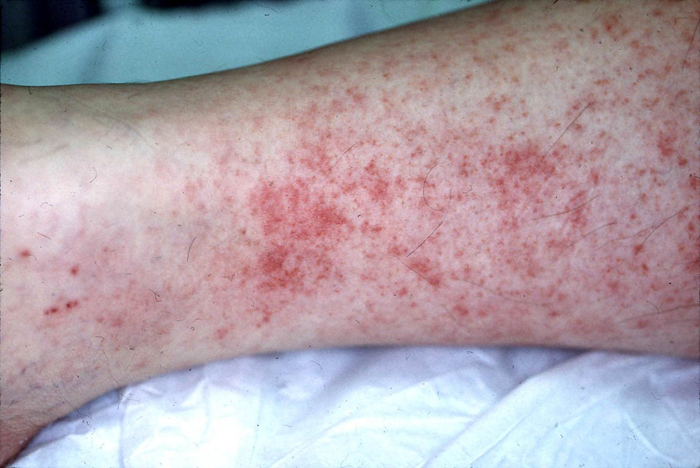
Rocky Mountain spotted fever (RMSF), the most severe of the rickettsial spotted fevers, is characterized by sudden onset of fever, severe headache, myalgia, and a characteristic acral exanthem; it is associated with significant morbidity and mortality rates.
Causes of RMSF
RMSF is caused by an infection with the bacteria Rickettsia rickettsii. Feeding by ticks usually takes place for ≥6 h, after which rickettsiae are released from the salivary glands. After inoculation of rickettsiae into the pool of blood in the dermis, initial local replication of rickettsiae occurs in endothelial cells, which is followed by hematogenous and lymphatic dissemination. Organisms spread throughout the body and attach to the vascular endothelial cells, the principal target. Foci infected by R.rickettsii enlarge as rickettsiae spread from cell to cell, forming a network of contiguously infected endothelial cells in the microcirculation of the dermis, brain, lungs, heart, kidneys, stomach, large and small intestines, pancreas, liver, testes, skeletal muscle, and other organs and tissues. Focal infection of vascular smooth muscle causes a generalized vasculitis. Patients with severe infection of brain and lungs have a high mortality rate. Hypotension, local necrosis, gangrene, and DIC may follow. Rash results from extravasation of blood after vascular necrosis.
Symptoms of RMSF
Symptoms of RMSF begin within two weeks of the bite of the infected tick. he most common symptoms of Rocky Mountain spotted fever are the abrupt onset of fever, severe headache, muscle aches, and vomiting. Other symptoms that are less common are abdominal pain, swollen lymph nodes, cough, stiff neck, confusion, and coma.
The Rocky Mountain Spotted Fever Rash
The rash that makes RMSF a “spotted” fever may begin anytime between 1 to 10 days after the fever and headache start, but it most often appears on the third to fifth day. The rash looks like small red spots or blotches that begin on the wrists, ankles, palms, and soles. It spreads up the arms and legs toward the trunk, but often spares the face.
Diagnosis
The disease is diagnosed by special blood tests.
Clinical and epidemiologic considerations more important than a laboratory diagnosis in early RMSF. Suspect in febrile children, adolescents, and men older than 60 years of age-particularly those who reside in or have traveled to the southern Atlantic states and South-Central states from May through September and participated in outdoor activity. Diagnosis must be made clinically and confirmed later. Only 3% of cases with RMSF present with the triad of rash, fever, and history of a tick bite during the first 3 days of illness.
Treatment
Antirickettsial Therapy Specific antirickettsial therapy should be initiated as soon as the diagnosis is suspected clinically.
Drug of Choice Doxycycline (except for pregnant patients, history of allergy to doxycycline, or possibly a child younger than 9 year of age), 200 mg/d PO or IV in two divided dose: for adults. Tetracycline, 25 to 50 mg/kg/d in four divided doses.
Alternative Chloramphenicol, 50 to 75 mg/kg/d in four divided doses.
Supportive Therapy For acute problems of shock, acute renal failure, respiratory failure, prolonged coma.
Prevention
- Avoid tick bites: protective clothing, tick repellants.
- After possible exposure, inspect for ticks.
- Use an insect repellent that works against ticks, being careful to follow label directions.
- Children and adults who are outside in tick-infested areas should wear long clothing and tuck the end of the pants into the socks.
References